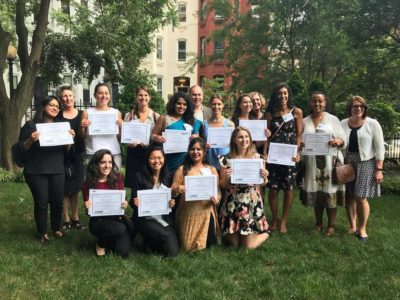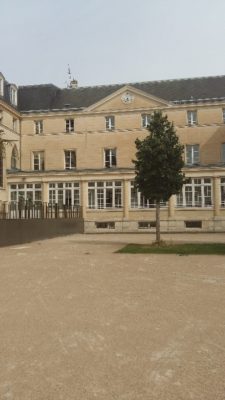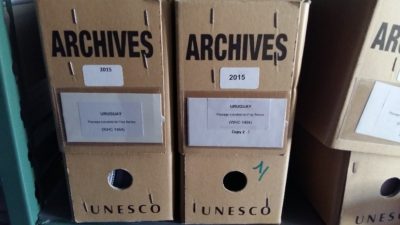Summer exchange program: International collaboration in public history
14 June 2018 – Joana Arruda

2017 ICOMOS IEP Participants. Photo credit: Richa Pandy
“What I would like to see in the future is more of an emphasis on cooperation between museums in the international community. In an increasingly connected world, it only serves [to] the benefit of the American public history sector to create bridges with other institutions.”
The above statement is excerpted from the blog I kept during graduate school where I sought to answer the prompt: “The Future of Public History—Where is it Going?” I spent much of my time as a public history student curious about collaborative public history work done across international lines. This research turned into my M.A. thesis on the National Park Service (NPS) Division of International Affairs, which was founded in 1961 to provide both technical assistance to nations seeking to build national parks and exchange information about conservation internationally. (I wrote about this research in a previous History@Work post.) Just four years later, in 1965, the International Council of Monuments and Sites (ICOMOS) was created “to promote the conservation, protection, use and enhancement of monuments, building complexes and sites.” I was fascinated by what the similar frameworks and philosophies of postwar organizations could tell us about the emergence of public history as a field of practice.
In the recently published Oxford Handbook of Public History, several public history scholars and practitioners analyze the field’s methodologies from a global perspective. In particular, Serge Noiret and Thomas Cauvin’s “Internationalizing Public History” chapter introduces this discussion by re-imagining the origins of public history methodology. They focus on the forms it has taken in recent decades, specifically through international collaboration and engaging the local through the lens of the global. Noiret and Cauvin explain that while the concept of “public history” emerged in the English-speaking world, particularly in the United States, it is possible to identify related perspectives by examining countries such as France.[1]
Armed with knowledge of these historical precedents and a minimal understanding of the current state of international projects, I had an opportunity to engage in public history work in a global, transnational context. In the summer of 2017, I spent ten weeks in Paris, France at the ICOMOS International Secretariat. In addition to its overarching mission as outlined in the Venice Charter of 1964, ICOMOS works with UNESCO in evaluating culturally significant sites on the World Heritage List and assists in designating this status at the annual World Heritage Convention. Over 100 nations have ICOMOS national committees responsible for engaging with issues of preservation at home while collaborating within a larger network of heritage professionals.
My time at ICOMOS was facilitated through US/ICOMOS. Based in Washington, D.C., it participates in this network through its annual International Exchange Participant (IEP) Program. Since the program’s founding in 1984, it has placed American and international graduate students and young professionals in cultural institutions in the United States and other countries. As a professional development program, its goal is to foster dialogue and cultural exchange internationally. Along with twelve other IEPs from five countries with backgrounds in archaeology, architecture, and historic preservation, I spent time in Washington before my assignment to Paris discussing how ICOMOS defines “heritage” work. We spoke with professionals in the NPS and the National Trust for Historic Preservation regarding international collaboration, climate change, sustainability, and community-based activism. We supplemented these conversations with visits to institutions including the National Museum of African American History and Culture, the National Building Museum, and President Lincoln’s Cottage.
Through my interactions with professionals from closely related fields, I was intrigued by their rigorous engagement with issues of community, preservation, and heritage. While public historians are likewise involved in these questions, I was surprised to be the only historian in the group. What is the role and benefit, then, of historians in these types of international cross-cultural exchanges?

ICOMOS International Secretariat, Charenton-le-Pont, France.
Photo credit: Joana Arruda
Following orientation, I traveled to France to begin my assignment at the ICOMOS Documentation Centre, located in Charenton-le-Pont on the outskirts of the Parisian twelfth arrondissement. Inaugurated in the 1970s, the Centre disseminates information in various languages about issues ranging from conservation science to archaeology, architecture, and local development. One of its primary goals is to serve as a central archive for professionals developing in these related fields.[2] Most importantly, it serves as a repository for the documentation that nations submit to ICOMOS to have their historic and cultural sites considered for the World Heritage List. ICOMOS then sends experts to evaluate these sites, whose analyses are used to determine a site’s significance in the context of World Heritage criteria. Using the WINISIS digital cataloging system developed by UNESCO, I cataloged maps, interpretive plans, landscape designs, and digital media sources from the sites inscribed on the World Heritage List in 2016. On my second to last day, ICOMOS received the files back from UNESCO of the sites inscribed in 2017 at the World Heritage Convention in Krakow to be archived on-site. I began the process of copying digital files according to ICOMOS standards for archival purposes.
The other major project that occupied the summer was my work to compile a bibliography for consultants hired by ICOMOS to evaluate sites on the 2018 World Heritage Tentative List. The works I selected for each site were used by scholars conducting site visits to understand the context of each site’s region, history, and political climate. Other projects I worked on included processing collections of books and reports, managing the ICOMOS PhotoBank, and translating a variety of French-language documents into English.

UNESCO Archives at ICOMOS Documentation Centre. Photo credit: Joana Arruda
My work at ICOMOS served as more than just an experience traveling overseas. Thinking about and discussing the preservation of these documents on-site and online in different languages was a foray into examining what public history looks like in a linguistic context where this term does not exist in the same way as in the English-speaking world. My role as a public historian was to preserve ICOMOS’ intellectual authority on conservation and to think critically about how this shapes its institutional memory.
This work left me thinking about the relationship that experts evaluating World Heritage sites have with the local communities who are seeking this status. The complex relationship between experts and communities relates to Noiret’s and Cauvin’s ideas about how public historians are actively engaging the local through the global. Perhaps serving as critical analysts and facilitators is the niche where public historians fit best in this type of “heritage” work, as they are well-equipped to engage with questions of community and the past in intricate and compelling ways. Furthermore, they possess the perspective to critically question the extension of American power overseas. This power dynamic is complicated by the United States’ official departure from UNESCO in 2018. The U.S. government has not paid UNESCO dues since 2011 due to the UNESCO’s extension of membership to Palestine, and its recent departure may affect the future of the work I have described here.
I would like to see public historians engage further with these types of questions. However, I see international public history as not only about the literal movement of practitioners. I envision examples of local projects that engage global issues in a post-national moment to identify and build connections in unexpected ways. Formed in 2010, the International Federation of Public History is a positive starting place for these conversations. As Noiret and Cauvin write, exploring the local through the lens of the global is a fascinating way to address issues that matter historically wherever you are. Ultimately, incorporating these methodologies is another niche that would allow public historians to learn about how our field understands place in a more global context.
~ Joana Arruda is a public historian whose research interests include the twentieth-century United States, material culture, and the National Park Service. Most recently, she served as the international exchange participant in Paris, France with the International Council of Monuments and Sites.
[1] Serge Noiret and Thomas Cauvin, “Internationalizing Public History,” in The Oxford Handbook of Public History, eds. James B. Gardner and Paula Hamilton (New York: Oxford University Press, 2017): 25-43.
[2] For more detailed information on the Documentation Centre’s history and role, please consult: http://www.icomos.org/en/about-the-centre/documentation-centre-s-history.



